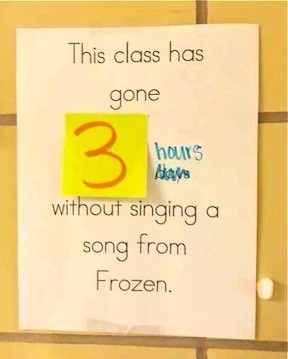
Last month, Frozen became the fifth highest grossing movie of all time, bringing in $1.2 billion at the box office. It’s the most successful animated film ever and the star of the Disney stable. It’s also probably the film I’ve seen or heard snippets of more than any other. Ever. And that’s not entirely as the result of having a five year old daughter.
I’m convinced that Frozen’s commercial success is linked to its status as Disney’s most viral film. In the past, Disney guarded the copyright for its films closely, with intellectual property lawyers around the globe carefully monitoring all uses. With Frozen, not only has Disney distributed content through social channels, but it has allowed tributes, parodies, reactions and recreations to flourish online, flooding YouTube and filling Facebook feeds around the world.
Given the lag between cinema release and DVD sales, this has helped to keep the story, characters, and yes, the songs, top of mind with the target audience. Rather than moving on to the next thing, the viral distribution of content has kept Frozen firmly on the radar. With that in mind, I offer up my top three tips for content distribution (with sincere apologies if any of these points give you an earwig).
1) Let it go
The days of being to be able to control all interactions with our brands or content are long behind us. While there may be times when they seem like the good old days, embracing the many channels to distribute your content can deliver real audience connections and help you find the fans you didn’t know you had.
Disney not only released versions of the Frozen songs on YouTube, they included deleted scenes. But more importantly, they took a relaxed view of the copyright. All those cute lip syncs of the film’s hits are walking close to the line on copyright infringement. Instead of shutting down these tributes, Disney has allowed them to flourish, providing a constant feed of Frozen through social.
2. Do you want to build a snowman?
Creating great, shareable, branded content needs to be a matter of collaboration. If you’re adding a brand later, or fitting content to tell your brand story, it’s not native or natural.
I’ve always found the best way to create collaborative content is to start with the problem, not the solution. The sooner you can get in a room and talk about what it is you’re trying to achieve, the easier it is to start sketching the concept together, with real back and forth. To do that there needs to be an element of trust, even if that means sometimes the best content comes in the subsequent campaign rather than out of the gate.
3. Fixer upper
There is a point when you’re sharing your content when you have to accept you may not like all the interactions you see. Yes, that comment cuts, that description of your photo is less than flattering, and oh dear that earnest warbling of your carefully crafted melody isn’t quite what you had in mind. But accepting, even embracing the imperfections in the way people respond to your content and brand allows the conversation to reach new audiences and find new ways of connecting with fans.
I’m not entirely sure I’m grateful to Disney for taking such an enlightened approach to content distribution for Frozen. Regardless, it has certainly provided some interesting examples of how releasing control can help meet a brand’s objectives.